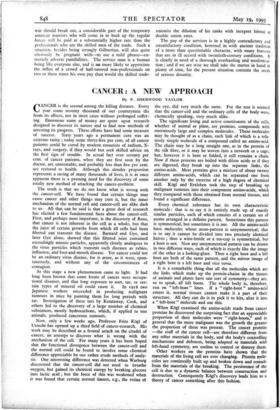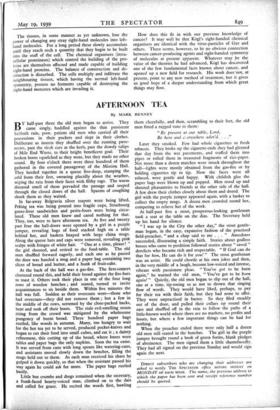CANCER: A NEW APPROACH
By F. SHERWOOD TAYLOR
CANCER is the second among the killing diseases. Every year some seventy thousand of our countrymen die from its effects, not in most cases without prolonged suffer- ing. Enormous sums of money are spent upon research designed to discover its nature and to find new methods of arresting its progress. These efforts have had some measure of success. Sixty years ago a permanent cure was an extreme rarity ; today some thirty-five per cent. of all cancer patients could be cured by modern resources of radium, X- rays, and surgery, if they would but seek skilled advice on the first sign of trouble. In actual fact over seventy per cent. of cancer patients, when they are first seen by the doctor, are untreatable, and probably less than five per cent. are restored to health. Although this slender proportion represents a saving of many thousands of lives, it is at once apparent there is a pressing need for the discovery of some totally new method of attacking the cancer-problem.
The truth is that we do not know what is wrong with the cancer-cell. We have found that certain things may cause cancer and other things may cure it, but the inner mechanism of the normal cell and cancer-cell are alike dark to us. All that can be said is that a great deal of research has elicited a few fundamental facts about the cancer-cell. First, and perhaps most important, is the discovery of Rous, that cancer is not inherent in the cell as a whole, but that the juice of certain growths from which all cells had been filtered can transmit the disease. Barnard and Gye, and later Gye alone, showed that this filtered juice contained exceedingly minute particles, apparently closely analogous to the virus particles which transmit such diseases as rabies, influenza, and foot-and-mouth disease. Yet cancer could not be an ordinary virus disease, for it arose, as it were, spon- taneously, and without any of the circumstances of contagion.
At this stage a new phenomenon came to light. It had long been known that some forms of cancer were occupa- tional diseases, and that long exposure to soot, tar, or cer- tain types of mineral oil could cause it. In 1918 two Japanese workers succeeded in producing malignant tumours in mice by painting them for long periods with tar. Investigation of these tars by Kennaway, Cook, and others led to the discovery of a large number of chemical substances, mostly hydrocarbons, which, if applied to test animals, produced cancerous tumours.
Now, only a few weeks ago, Professor Fritz Kogl of Utrecht has opened up a third field of cancer-research. His work may be described as a frontal attack on the citadel of cancer, an attempt to discover what is wrong with the mechanism of the cell. For many years it has been hoped that the functional divergence between the cancer-cell and the normal cell could be found to involve some chemical difference appreciable by our rather crude methods of analy- sis. One interesting difference was detected when Warburg discovered that the cancer-cell did not need to breathe oxygen, but gained its chemical energy by breaking glucose into lactic acid ; but the force of this was weakened when it was found that certain normal tissues, e.g., the retina of the eye, did very much the same. For the rest it seemed that the cancer-cell and the ordinary cells of the body were, chemically speaking, very much alike.
The significant living and active constituents of the cells, whether of animal or plant, are proteins, compounds with enormously large and complex molecules. These molecules may be thought of as a chain, each link of which is a rela- tively simple molecule of a compound called an amino-acid. The chain may be a long straight one, as in the protein of the silk fibre, or it may be woven into a network or a cage; but, however it is bent or folded, it still remains a chain. Now if these proteins are boiled with dilute acids or if they are digested, they break up into the separate links, the amino-acids. Most proteins give a mixture of about twenty different amino-acids, which can be separated one from another only by the exercise of a high degree of chemical skill. Kogl and Erxleben took the step of breaking up malignant tumours into their component amino-acids, which they compared with those obtained from normal tissues, and found a significant difference.
Every chemical substance has its own characteristic molecule: that is to say it is entirely made up of exactly similar particles, each of which consists of a certain set of atoms arranged in a definite pattern. Sometimes this pattern is symmetrical, but sometimes it is not. All the amino-acids have molecules whose atom-pattern is unsymmetrical; that is to say it cannot be divided into two precisely identical halves ; thus a wine-bottle or a tea-cup is symmetrical, but a boot is not. Now any unsymmetrical pattern can be drawn in two different ways, each of which is exactly like the image of the other in a looking-glass. Thus a right boot and a left boot are both of the same pattern, and the mirror image of a right boot is a left boot and vice versa.
It is a remarkable thing that all the molecules which are the links which make up the protein-chains in the tissues of animals and plants have one sort of symmetry—they are, so to speak, all left boots. The whole body is, therefore, run on " left-boot " lines. If a " right-boot " amino-acid enters it, normal tissues cannot make it a part of their structure. All they can do is to pick it to bits, alter it into a " left-boot " molecule and use this.
When Kogl examined the amino-acids made from cancer proteins he discovered the surprising fact that an appreciable proportion of their molecules were "right-boots," and in general that the more malignant was the growth the greater the proportion of these was present. The cancer proteins —the stuff of the cancer cell—are therefore different from any other materials in the body, and the body's controlling mechanisms and defences, being adapted to materials with left-hand symmetry, are useless to control or destroy them.
Other workers on the proteins have shown that the materials of the living cell are ever changing. Protein mole- cules are continually built up and broken down and remade from the materials of the breaking. The persistence of the cell is due to a dynamic balance between construction and destruction. Consequently Keigl's discovery leads him to a theory of cancer something after this fashion. The tissues, in some manner as yet unknown, lose the power of changing any stray right-hand molecules into left- hand molecules. For a long period these slowly accumulate until they reach such a quantity that they begin to be built into the stuff of the cell. The chemical organisers (intra- cellular proteinases) which control the building of the pro- teins are themselves affected and made capable of building right-hand proteins. The balance of construction and de- struction is disturbed. The cells multiply and infiltrate the neighbouring tissues, which having the normal left-hand symmetry, possess no ferments capable of destroying the right-hand monsters which are invading it. How does this fit in with our previous knowledge of cancer? It may well be that Kogl's right-handed chemical organisers are identical with the virus-particles of Gye and others. There seems, however, to be no obvious connection between cancer-producing agents and right-handed symmetry of molecules at present apparent. Whatever may he the value of the theories he had advanced, Kogl has discovered one of the few fundamental facts known about cancer, and opened up a new field for research. His work does not, at present, point to any new method of treatment, but it gives us good hope of a deeper understanding from which great things may flow.



















































 Previous page
Previous page